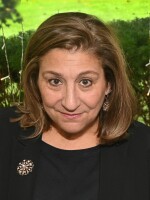Mark Campbell and his family traveled from Overland Park to Vincennes, Indiana to catch the total solar eclipse.
"Very temperate, clear skies, only high cirrus clouds in the skies," he told KCUR's texting exchange on Monday morning. "We are ready and excited!"

People on both sides of the state line seized their opportunity to catch totality by traveling to Arkansas, Texas, Missouri and Illinois.
One Wichita astronomer headed to Austin, Texas, with his wife, and Carbondale, Illinois, was flooded with solar enthusiasts hoping for clear skies.
"Traveled to Wimberley, Texas, to see the totality!" another text told KCUR Monday morning. "Took my 2 kids out of school. We saw the totality in Kearney, Missouri, in 2017 and it's important to witness these things when you can because it's rare!"

Thousands more in Kansas City fanned out across the metro Monday, hoping to experience a veil of darkness in the middle of the afternoon.
At the amphitheater in Legacy Park in Lee's Summit, more than 200 people showed up for a watch party.

Another watch party cropped up at the Overland Park Arboretum.
Emily Walkenshaw, 20, and Sierra Woolschlager, 20, drove up from Clinton, Missouri. They walked around the arboretum Sunday just before closing, and decided to come back to watch the eclipse.
Just inside the park mid-morning on Monday, they ran into others who'd also come early to settle in and gaze up at the sky. The new friends ended up spending the day together.
“We've never been here," said Terisa Thomas, who came with her 19-year-old son, Shaun. "I just looked up where's the best place to see the eclipse. Then we got probably about 10 or 15 feet in, saw (them) and started talking. We just kind of all met today."

Kansas City is just outside the so-called "path of totality," in which the sun is completely covered by the moon, temperatures fall and animals freak out when it turns dark.
Angela Elam, 67, went to the Baker Wetlands in Lawrence, Kansas, to experience the eclipse, "listening to birds, bees and frogs, waiting to see if they go quiet."
After the eclipse was over, we asked if the wildlife noise did die down. "Not really," she said. "The bees kept buzzing around the beehive. The birds and frogs got a little quieter but didn't go silent. It just didn't get dark enough, but it was still nice to take the moment during the day to just watch and listen to the natural world."
But the temperature did drop noticeably as the moon covered the sun, and colors looked strange as the eclipse dimmed red color wavelengths and brought out greens.
"Viewing from work (KC Zoo) and school," one person texted KCUR. "Wish we could have traveled. Important to us bc we are a STEM loving family with a special interest in astronomy. We are excited!"

North America has been spoiled with two solar eclipses close together — the last one was in 2017 — but it will be another 20 years until eclipse fans get the chance to see another eclipse over the continental U.S.
"It's not complete totality that we're witnessing, but the setting at the lake is (still) lovely," Mark Winkler texted KCUR from Stockton, Missouri, moments after the eclipse was over. "We're putting our sailboat back in the water."

Whether you make it to the path of totality or not, it's essential to be safe as you take in the celestial event. Wear safe eclipse glasses, use your phone camera wisely and prepare your pets.
This story uses information gathered from KCUR's texting service. Learn more and sign up here.







